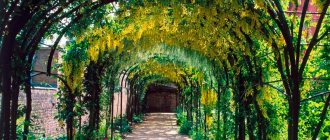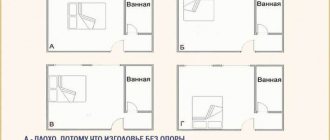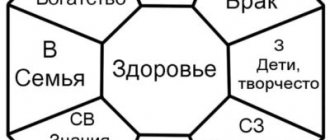You do everything to be rich: you earn money, you save money, you invest money. But there are still not enough funds?
Where is the wealth zone in your premises? What part of your home and office is responsible for the flow of money?
If the answer is “I don’t know,” then you are probably not doing the most important thing, without which it is impossible to be rich - do not strive for internal and external harmony.
This article provides recommendations for landscaping the wealth zone according to Feng Shui and Vastu Shastra.
Which of the ancient teachings should you give preference to? Whatever you like best. If you want, apply all the acquired knowledge at once! There is not much difference between them, much less contradictions.
Earth as a zone of wealth
Planet Earth is abundant, so being rich while living on it is natural.
Poverty is a sign of a departure from one’s nature, of internal inconsistency. The psychology of poverty leads to a lack of material goods.
A number of internal conflicts that prevent you from “making friends” with money need to be eliminated.
Since everything external reflects the internal, your home is also a reflection of you.
External changes and transformations in the house help to make a “monetary revolution” inside.
Moving objects in a living space is not a simple rearrangement, but a way to transform life globally and, in particular, to get rich.
Ignorance of the laws of the Universe does not exempt one from responsibility. You may not know or believe that the wealth zone in the home can be blocked, but continue to experience problems with money.
Vastu Shastra is an ancient Vedic teaching, originally from India, Feng Shui is ancient Chinese. In many ways they are similar. These are teachings about the improvement of space according to the laws of the Universe.
There is debate about which of them is more ancient, correct, and acceptable for the Slavs. However, they work equally effectively.
Read more about ancient teachings in the articles:
Vastu Shastra for home. Sacred knowledge has been declassified!
Feng Shui zones in the house: how to find and activate?
The wealth zone according to Feng Shui and Vastu Shastra can be adjusted:
- cleared,
- ennobled,
- changes.
Millions of people make changes to space with one goal - to attract material wealth. Try and change your life easily and simply - by arranging your home or office in a special way.
Vastu rules for an apartment
The central part of the apartment and the plot is under the patronage of the god Brahma, the creator of the world. In India, the central part of a house or plot is called Brahmasthan or simply Brahma. If the house or plot has the shape of a square, then the classical Paramasaika, consisting of 81 squares, can easily be superimposed on its plan, and then Brahmasthan will occupy the central 9 squares. In Vastu, it is not recommended to load the Brahmasthan with furniture, place heavy objects, and especially not to make toilets or storage rooms there. Brahmasthan should be an open space: in a private house there should be a courtyard, and in an apartment there should be a family altar.
© Ogudin Valentin
Wealth zone according to vastu
In vastu shastra the zone of wealth is:
- North - this includes the energy of wealth around the clock.
- East - here streams of abundance pour out at dawn.
The energy of wealth leaves the house through:
- West,
- Southwest,
- South,
- Southeast.
Hence 2 tasks:
- Let the energy in through the North-East wealth zone (N, NE, E).
- Do not let it flow out through the West - Southeast (W, SW, S, SE).
Two important conditions for wealth according to Vastu, which at first glance are not related to money:
- Health and happiness of the housewife. The hostess is the personification of the Goddess of prosperity named Lakshmi . It is a woman, being healthy and happy, who ensures material well-being in the family. Notice! Not by earning money or working for the benefit of someone, but by being happy and healthy, the mistress of the house contributes to the enrichment of the whole family!
- Cleanliness and tidiness. Wealth does not come to a dirty house littered with junk and things with negative energy. Such a chaotic house takes away not only money - health, harmony, mutual understanding, and other benefits.
For more information about cleaning the house according to Vastu, read “Cleansing the house before the New Year.”
| What to add to the N, NE, B wealth zones: | What to fix in wealth zones | |
| 1 | Water - a fountain or mini-pond | Wash the windows, remove all plants from the windowsill |
| 2 | Safe for all valuables with a door opening towards the North | Throw away trash, trash, anything broken, beyond repair, unnecessary |
| 3 | If there are no windows, hang mirrors on the walls | Remove heavy, massive furniture (move to the South) Bulky furniture should also not be in the NW |
| Throughout the house: | ||
| 1 | Lubricate squeaky doors | |
| 2 | Repair taps, toilets (must not leak) | |
| 3 | Take care of the strength, cleanliness and beauty of the front door | |
Interestingly, paper money is not considered valuable according to vastu shastra. Therefore, for example, it is better to put precious metals and jewelry in a safe in the North to attract wealth.
From Gulyai-Polye to Butyrka
Nestor Makhno became acquainted with anarchism at the age of sixteen, joining the “Peasant Group of Anarcho-Communists” (this circle was also known as the “Union of Free Grain Growers”), operating in his native village of Gulyaypole. By this time, Makhno had a half-starved childhood and early work experience behind him, so he burned with uncontrived hatred for the exploiters. The period between the first Russian revolution and the February Revolution was the heyday of Russian anarchism, and sixteen-year-old Nestor actively participated in all the circle's operations, mainly related to expropriations. This brought him to prison: two detentions ended in release, but the third time, for the murder of a military official, he and sixteen comrades were sentenced to hanging in 1910, which, due to his youth, was replaced with indefinite hard labor. True, Makhno never got there: he spent almost seven years in Butyrka prison in Moscow and was released after the February Revolution.
"Peasant group of anarcho-communists" of Gulyai-Polye in 1907. First on the left in the first row is 19-year-old Nestor Makhno
Source: commons.wiki.org
Deadly legacy from Butyrka
Despite all his talent as a tactician and partisan, Nestor Makhno was ultimately defeated by the Red Army and was forced with a small detachment of associates to leave for Romania. The Romanian government refused the demand to extradite him to Soviet Russia, but did not want to keep the dangerous rebel, organizing Makhno and some of his comrades to escape to Poland. There, the famous anarchist was accused of preparing an uprising in Galicia, after which he was acquitted and exiled to the free city of Danzig, from where he moved to Germany and then to France. In recent years, Nestor Makhno lived the same half-starved life as in childhood, and this led to an exacerbation of chronic tuberculosis. He acquired this disease in Butyrka prison after repeated imprisonment in a punishment cell for participating in prison riots. Later, he had to remove one lung to stop the development of the disease, but the difficult life in exile caused an exacerbation. On July 6 (according to other sources - 25) July 1934, Nestor Makhno died in a Paris municipal hospital.
Nestor Makhno with his daughter Elena in Paris, second half of the 1920s
How Father Makhno met Lenin
Nestor Makhno’s return to his homeland was, if not triumphant, then very joyful: revolutionary romance had not yet given way to bitterness, and his fellow countryman, who escaped from prison, was greeted with honor in Gulyai-Polye. Makhno immediately became involved in political life, trying with all his might to put into practice the knowledge and ideas about anarchism that he received in his prison cell from his fellow prisoners. After the beginning of the German occupation of Ukraine, Makhno, together with the remnants of his fighting squad “Black Guard”, retreated to the territory of the RSFSR, after which he decided to get a more detailed idea of the system that was created on the territory of this republic. It was within the framework of this political tour that the future leader of the peasant army met in 1918 with the Chairman of the Council of People's Commissars, Vladimir Lenin, after which he returned to his homeland to begin the revolutionary struggle.
Nestor Makhno in 1918 during the formation of the rebel army after returning from Soviet Russia
Source: commons.wiki.org
Brigade commander with two classes of education
The highest official military rank of Nestor Makhno was the rank of brigade commander, received in 1919, when his army became part of the Ukrainian Front as the 3rd Trans-Dnieper Brigade. In the anarchic peasant republic created by Makhno on the territory of his native Gulyai-Polye and adjacent districts of the Yekaterinoslav province, he was simply called “father.” However, he never received any systematic education, especially military education. As a child, Makhno managed to graduate from two classes of the zemstvo school; later, in the Butyrka prison, he expanded his horizons, studying mathematics and history under the guidance of the anarchist Pyotr Arshinov. But all this did not prevent the leader of the peasant freemen from proving himself to be an excellent tactician, whose abilities, not without discontent, but fairly, were recognized by both Lieutenant General Anton Denikin and Army Commander Mikhail Frunze. Suffice it to say that in the summer of 1919, the breakthrough of Makhno’s army from the encirclement of Denikin’s troops and the raid on their rear largely predetermined the failure of Denikin’s attack on Moscow, and at the end of 1920, Red Army formations suffered a failure in an attempt to destroy the main forces of Makhno’s army, which Army Commander Frunze called “ St. Andrew's embarrassment."
Nestor Makhno with his wife Galina Kuzmenko surrounded by his associates, Poland, 1922
Source: commons.wiki.org
Beat whites always, and beat reds when necessary
Surprisingly, Nestor Makhno’s active revolutionary and military activities lasted only three years - from 1918 to 1921. But during this time, he managed not only to create a real partisan army and develop a classic partisan strategy (many elements of which were used by Soviet partisans two and a half decades later), but also to fight on the side of the Bolsheviks. Makhno entered into an alliance with them twice: in 1919, his army became part of the 1st Trans-Dnieper Soviet Ukrainian Division of the Ukrainian Front, and in 1920, a detachment of Makhnovists participated in the liberation of Crimea from the Wrangelites. But both times Makhno himself and his comrades quickly broke off relations with the Red Army. And both times - after the Bolsheviks tried to extend their regular rules to the anarchist freemen. However, Makhno fought consistently and unconditionally with the Whites: neither Anton Denikin nor Peter Wrangel managed to agree with his army on joint military operations. Moreover, in all his appeals Makhno called the Bolsheviks temporary allies and the Whites ideological opponents.
Commander of the 1st Trans-Dnieper Ukrainian Soviet Division Pavel Dybenko and commander of the 3rd Trans-Dnieper Brigade Nestor Makhno, late 1918
Source: commons.wiki.org
What is Vastu Shastra and how did it come into being?
Vastu Shastra (“science of construction” from Sanskrit) - system Pasachoff J., Percy J. Teaching and Learning Astronomy: Effective Strategies for Educators Worldwide.
Cambridge University Press. 2009 architectural planning and design in Hindu, as well as some Buddhist beliefs, based on ideas about the aura of a home. The concept describes ways of constructing, planning and furnishing a house, based on the idea of unity with nature and harmony with the elements. For this purpose, geometric patterns, principles of symmetry and adherence to directions are used. Vastu Shastra originated in Ancient India. The system is mentioned by Patra RT A Comparative Study on Vaastu Shastra and Heidegger's "Building, Dwelling and Thinking". Asian Philosophy in the Vedas, for example in the Rig Veda, the text of which was compiled 3-3.5 thousand years ago. The ancient Indian epic Mahabharata contains a lot of information about vastu. The mythical founder of Vastu Shastra is considered to be the History of Vastu Shastra. Vasthurengan.com sage carpenter Mamuni Mayan, who discovered its principles thousands of years ago.
Even in those days, Indian temples, as well as the ponds and gardens surrounding them, were designed according to Vastu theory.
Vastu Shastra is considered a written part of the teachings of Vastu Vidya, the broader Hindu system of guidelines for architecture and design. It is essentially a mixture of Patra RT A Comparative Study on Vaastu Shastra and Heidegger's "Building, Dwelling and Thinking". Asian Philosophy of geometry, philosophy, religion and astrology.
According to the canons of Vastu Shastra, one of the largest religious monuments in the world, Angkor Wat, was built. Photo: RM Nunes/Shutterstock
Vastu - Indian Feng Shui
Vastu is the ancient Vedic science of the rules of construction and interior design of buildings, which originated in India more than 5,000 years ago.
According to the principles of this teaching, palaces and temples were built, in which the first place was given to the correct organization of the circulation of energy flows emitted by the four cardinal directions: south, north, west and east.
Buildings planned according to vastu are in harmony with all the nature around them. Even psychologists note that in these rooms any person feels peace of mind and tranquility.
This practice of Vedic architecture is also applicable in modern houses and apartments; it will bring happiness, prosperity and peace of mind to their owners.
Using Vastu principles, you can:
♦ turn your home into a temple for communication with God;
♦ improve family relationships;
♦ attract prosperity to the house;
♦ improve health through proper energy flow
through the body;
♦ calm the mind and improve mental balance;
♦ prepare a place for development in all areas of life.
Modern house or apartment according to vastu
If you are buying a ready-made home, then you need to choose one where the front door is in the east, the bedroom is in the southwest, the kitchen is in the northwest or southeast, and the northern and eastern parts have a lot of free space. If it is not possible to comply with these rules, then in this case the furniture must be placed so that the east, north, and center of the rooms are always free. Under no circumstances should windows be cluttered with anything.
All furniture that has empty spaces inside, for example, wardrobes, chests of drawers, mezzanines, bookshelves and periodicals, should be placed in the north-west of the rooms. It is better to paint the master's office and children's study rooms in a pale green color - it promotes mental work and better concentration.
You should sleep in the southwestern wing of the house or apartment with your head facing the east or south. If the master's bedroom is located in the southeast, this will invariably lead to lack of money and frequent quarrels. According to Vastu teachings, one should not sleep under overhanging beams or an arch, and also place the bed in the middle of the room, let it stand against the wall without touching it. A healthy, good sleep will be ensured in a blue or light blue bedroom.
Throughout the house, especially in the northern and eastern parts, you need to hang paintings with images of natural landscapes, flowers; in India it is also customary to place statues of deities everywhere that attract good luck or material prosperity. Avoid any images of violence, death or poverty, and photographs of the deceased should only be hung on the south side. By the way, the total number of doors, as well as windows and even ventilation holes, must be an even number, but not end in zero.
The ancient sages noted that the early morning sun with its soft light is a source of calm and rejuvenating energy, while the midday sun is too intense and debilitating. This explains why yogis in India traditionally faced the northeast and the rising sun when they practiced morning yoga and meditation. They wanted to absorb this light with its healing power. The north-eastern room with a window is best suited for yogic practices.










